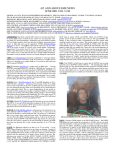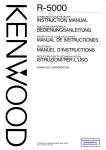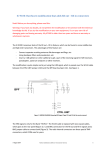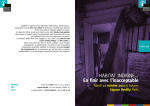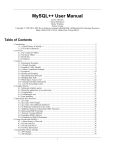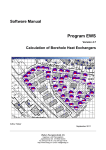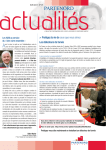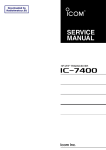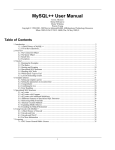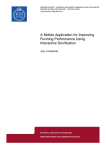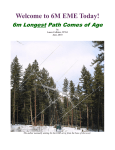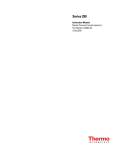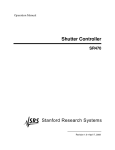Download What is TANT
Transcript
TANT V1.2 Illustrated add-on to the original “readme.txt” issued by Sinisa, YT1NT, VE3EA on April 23, 2006 ■ How to build proper EZNEC files for TANT ■ How to run TANT ■ How to interpret results Written by Hartmut, DG7YBN on Feb. 07 - 2009 with kind help of YU7EF and supervision by YT1NT. Illustrated Add-On to TANT 1.2 readme.txt, April 23, 2006 by YT1NT Written by DG7YBN on Feb. 07, 2009 What is TANT? TANT is a program written by Sinisa, YT1NT. It computes Far Field table output originating from antenna radiation pattern that have been produced with EZNEC from version 3 to the actual version 5.0 onwards (or any other exactly similar table format holding complete Far Field data). TANT calculates Antenna Temperature and G/T Ratio for antenna elevation angles from 0 to 90 degrees in steps of 5 degrees whilst assuming uniform sky- and earth temperatures for the full sight of sky sphere (π in radian) respectively earth up to horizon (2π in radian for polar coordinates). TANT is a DOS program that can be run from either MSDOS prompt or MS-DOS Console when using Windows environment. What is the actual version of TANT? TANT 1.2 What is the calculation base of TANT’s equations? Common Base for calculating the antenna temperature is the integration of infinite slices of Temperature in observation direction multiplied with equal slice of antenna beam characteristic in that direction over the sight of (noise -) temperature emitting environment. The well known article by Rainer Bertelsmeier, DJ9BV “Effective Noise Temperature of 4Yagi-Arrays for 432 Mhz EME” presents the full set of equations and theory. It is a good introduction to antenna temperature and G/T ratio. See Dubus-magazin 4/87 or http://www.mrs.bt.co.uk/dubus/8704-1.pdf (file size: 598 kB) How to install TANT TANT does not need to be installed. It consists of a single executable (.exe) file. Place it in the same folder as your EZNEC pattern files and run it from there. Terminology: TANT - refers to the programs name Tant - refers to Antenna Temperature in Kelvin [K] FF - Far Field Picture on front page: FF of 4 yagi bay of YU7EF’s 7 ele. yagis EF0207 made with 4nec2x (3D viewer extension) 2/13 Illustrated Add-On to TANT 1.2 readme.txt, April 23, 2006 by YT1NT Written by DG7YBN on Feb. 07, 2009 How to generate a Far Field table suitable for TANT analysis First you must build a proper Far Field table of your antenna with EZNEC. Building a Far Field Table <FF-Tab> – file that can be computed by TANT in three steps: Step 1: Build your EZNEC model file in a way that X axis = element position on boom Y axis = element length Z axis = height of element i.e. distance to ground Maximum gain must occur at elevation angle = 0 degrees and azimuth angle = 0°. Set parameter “Step Size” for pattern calculation accuracy to 1, 2 or at least 3 Degree. Set parameter “Ref. Level” to 0 dBi. (See EZNEC main window, underneath “Wires” window) Example file model: YU7EF ‘EF0213’ - 13 ele. yagi for 144 MHz in EZNEC+ v 5.0 * * The above design is the sole property of Ljubisa Popa, YU7EF. Distribution and publishing of these data and information is permited ONLY for radioamateur purposes and construction. Use of these information and data for any commercial purposes is strictly prohibited without the written authorization of Ljubisa Popa. 3/13 Illustrated Add-On to TANT 1.2 readme.txt, April 23, 2006 by YT1NT Written by DG7YBN on Feb. 07, 2009 Step 2: Select “Options” and set Parameter “Angle Convention” to “CCW From X Axis”. Next run Far Field Plot <”FF-Plot”> with “Plot Type” = “3D” to create the “Total Field” radiation pattern. Left: This is what your 3D pattern should look like (you do not need to highlight the azimuth slice as in this example). Pattern must not necessarily be symmetrical - since there are no shortcuts being taken in TANT's computing engine. The entire pattern must be present and integration is always over the entire space. Just make sure, that all axis are in place and maximum gain occurs at elevation angle = 0 deg. and azimuth angle = 0 deg. 4/13 Illustrated Add-On to TANT 1.2 readme.txt, April 23, 2006 by YT1NT Written by DG7YBN on Feb. 07, 2009 Step 3: How to generate the Far Field Table that TANT shall use to compute the antenna temperature and G/T ratio. Clicking the “FF Tab” button produces the 3D Far Field Table – Form (see below). Select option “Azimuth Slices” and check “Full Range”. Press “Ok” button and EZNEC will generate a .txt file containing the Far File data in a table. 5/13 Illustrated Add-On to TANT 1.2 readme.txt, April 23, 2006 by YT1NT Written by DG7YBN on Feb. 07, 2009 The FF Tab – file you just generated should look like this: The content of the second line may vary of course as it is depending on your comments to the NEC file. Valid for correct calculations by TANT is the Reference level of 0 dBi and the tables following the header. See notes below on Decimal Separator. Save this file using the “8+3 DOS filename” convention. In straight words: use a name with 6 characters followed by a period dot and ending txt (example: “ef0213.txt”). Important Note: Decimal separator for the table values must be a period “.” as TANT can not handle the comma “,” that you might eventually get due to the regional settings your Windows Controls. EZNEC does not provide the choice of what separator to use (see EZNEC User Manual on “Decimal Separator”). TANT will react on the comma separator with immediate shut down. If you dislike manipulating your PC’s Windows settings you may load the FF Tab file in some advanced Text Editor like MS Word or Open Office Writer and exchange commas with periods using the auto – replace function on whole text. Then save in .txt format again. Do not try this in MS-Editor: it will take ages to replace the average of 10.000…40.000 commas by periods. 6/13 Illustrated Add-On to TANT 1.2 readme.txt, April 23, 2006 by YT1NT Written by DG7YBN on Feb. 07, 2009 How to run TANT Start TANT by double clicking the TANT.exe file. Press any key and then press “1” to type in your FF Tab file name (example ‘ef0213.txt’). Then press “Return”. Finally press “4” to compute your file. The advanced user may vary “Sky Temperature” and “Earth Temperature” in similar manner. Do not change these figures at the moment and do not change them if you like to compare your data with the well acknowledged standard in the VE7BQH Temperature and G/T ratio Table (which is based on these environment temperatures and 30 degrees of antenna elevation angle). 7/13 Illustrated Add-On to TANT 1.2 readme.txt, April 23, 2006 by YT1NT Written by DG7YBN on Feb. 07, 2009 If TANT is running properly it shall look like this while computing: And this is what the output shall look like: Note the red line for 30 degree elevation angle for easier comparison with Yagi Analysis 3.54 (YA 3.54). This became the standard angle since it was chosen by DJ9BV as being a typical elevation angle [of the antenna] for EME applications. But there is nothing magic about 30 degrees. Depending on the application, some other elevation angle may be of more use for you. Values in this example are referring to the EF0213 yagi. 8/13 Illustrated Add-On to TANT 1.2 readme.txt, April 23, 2006 by YT1NT Written by DG7YBN on Feb. 07, 2009 How to interpret results Tant: Antenna temperature is computed in and displayed in 3 values: Tpattern - applies to a lossless antenna with exactly the same shape of the pattern as for Ttotal. This is arrived at by compensating for the loss as calculated below; Tpattern shows the "directional qualities" of the antenna pattern, ignoring ohmic losses. Ttotal - applies to the antenna pattern exactly as supplied by EZNEC Tloss = Ttotal – (Tpattern attenuated by the loss). The information on ohmic losses is contained in the EZNEC Far Field Table. It is the difference between 0.00 dBi and power gain averaged over all directions = Average Gain. The Average Gain is displayed on the Bottom Line of the EZNEC main window once you have run the 3D far field plot (see EZNEC User Manual on “Average Gain”): 9/13 Illustrated Add-On to TANT 1.2 readme.txt, April 23, 2006 by YT1NT Written by DG7YBN on Feb. 07, 2009 Antenna elevation: The following picture shows the Far Field of the example yagi in 30 deg. elevation. Do not arrange wires i.e. antenna in EZNEC in that position your self since you would loose the “maximum gain at 0°” convention. This picture is for demonstration only. TANT does this virtually for you in the output in steps of 5° over a variation from 0 to 90°. 30 deg. Example: YU7EF ‘EF0213’ - 13 element yagi for 144 MHz in EZNEC+ v 5.0 At an antenna elevation of 0° the Tpattern is always the average of TSky and TEarth for any antenna having a symmetrical pattern relative to the horizontal plane, regardless of the actual pattern, gain, losses, F/B, F/S or sidelobe level (see next §). G/T ratio: (as from VE7BQH G/T simulation table descriptions) G/T ratio is a figure of merit used to determine the receive capability of the antenna: G/T = (Ga + 2.15) - (10*log Ta) [dB] Example, using the EF0213 data: G/T = (14.02 dBD + 2.15 dB) - (10*log 223.9 K) = 16.22 dB(i) - (10*log 223.9 K) = 16.22 dB 23.50 dB = - 7.28 dB Interpretation: More positive (i.e. less negative) figures are better. Antenna gain Ga is in dB vs. dipole (dBD). The addition of 2.15 dB matches a figure vs. isotropic radiator (dBi). Temperature is expressed in dB by conversion with 10*log. 10/13 Illustrated Add-On to TANT 1.2 readme.txt, April 23, 2006 by YT1NT Written by DG7YBN on Feb. 07, 2009 What does that mean to terrestrial low signal communication? Excursion by YT1NT (edited by DG7YBN): May we consider a general case of an antenna with a symmetrical elevation pattern i.e. equal top and bottom half-spaces. This is always the case with • Single Yagis • Multiple Horizontally Stacked Yagis • Multiple Vertically Stacked Yagis with symmetrical current distributions, when all of these antennas are operated with an elevation of 0 degrees. In other words, this is almost always the case in terrestrial communication. Under these conditions, the 'antenna temperature' does not depend at all on the radiation pattern, and it is always: Tant = (Tsky + Tearth) / 2 (ignoring ohmic losses) As TANT is assuming uniform sky- and earth temperatures for the full sight (360° turn) of sky sphere respectively earth up to horizon what you get is just the medium value between TSky = 200 K and TEarth = 1000 K. Every per coordinate determined infinitesimal patch of environment in the sky has a complementary patch on the ground. Since the antenna pattern is symmetric, the gain per sky patch and complementary earth patch is equal. Hence all the integration mechanism may be crossed out of the equation. What is left may look as simple as this: (200 K + 1000K) / 2 = 600 K In straight words: • Tant will stay the same as long as the elevation pattern is symmetrical. • Tant will not depend on gain, sidelobes, F/B or F/R ratio, etc. Does this mean that Tant indicates absolutely nothing about antenna qualities for terrestrial communications? …. Yes, it indicates absolutely nothing if you take the Tant – figure for 0° of antenna elevation angle as an objective. This follows from the assumptions underlying the definition of antenna temperature (Tant) and specifically the assumption that Tearth is the same in all directions. If Tearth is the same in all directions then sidelobes and F/B ratio do not matter on the issue of antenna temperature. Of course, we all know that sidelobes and F/B ratio matter very much in real world terrestrial communication. But this is not taken into account in the Tant definition. Thus consequently Tant, as it is defined, can not express those valuable qualities of antennas for terrestrial communications. If we wanted to express the 'quality' of the antenna's directional pattern, we'd have to define different Tearth values in different directions. Until we do so, both, the assertions of Tant and TANT are of limited use for terrestrial work. We may only deduce, that a yagi with lower Tant than a referencing one at 30° elevation will be quieter in terrestrial work. 11/13 Illustrated Add-On to TANT 1.2 readme.txt, April 23, 2006 by YT1NT Written by DG7YBN on Feb. 07, 2009 Additional notes from original readme.txt as far as not mentioned above: Antenna temperature and G/T [ratio] are not parameters of the [sole] antenna itself. Instead, they are parameters of the entire “antenna + ambient” system. Ttotal = Tloss + (Tpattern attenuated by loss), exactly as TA in DJ9BV’s article. Whenever Tpattern > Tref (290K), any antenna loss will LOWER the Ttotal, i.e. it will DECREASE the total noise power towards the thermal noise power at Tref . Of course, this can not be used to improve G/T or S/N ratios. Based on the equations presented by DJ9BV the pattern temperature (Tpattern) is exactly the same as TA’ in DJ9BV’s article. It represents the sum of “forward”, “sidelobe” and “backward” temperatures (which is likely not the same as the sum of similar named values in YA 3.54). See § Notes for additional information. Please note, that terms “forward”, “sidelobe” and “backward” in DJ9BV’s Article (and like wise in YA 3.54) have nothing to do with your antenna’s pattern. They are just unfortunately chosen names for differential parts of the integration surface, related to the 30 degrees elevation used , and having no relation whatsoever to the actual antenna pattern. [Rainer (DJ9BV) had to give some name to those sections in which he split the integration paths of the complete pattern surface.] Please note that there is an error in DJ9BV’s article. In section 4 the integration surface is partitioned incorrectly to “forward”, “sidelobe” and “backward” parts. As stated there, the partitioning is correct only for azimuth values of 0 and 180 degrees. The noise temperature and G/T treatment in YA 3.54 seems to be based on DJ9BV’s article. However, with our antenna samples YA 3.54 results were in substantial agreement with TANT results, although it is not clear whether it was so because the error was small in the samples tested, or because YA 3.54 performed the integration correctly. You can keep TANT running while you work in EZNEC. When you’re ready, save the pattern file and select Compute in TANT. Bear in mind that 0.1 K accuracy in Tpattern or Ttotal would demand less than 0.002 dB error in pattern, which can not [be] expected from NEC modelling. Even the resolution of 0.01 dB in the EZNEC pattern file is far better than actual accuracy. 12/13 Illustrated Add-On to TANT 1.2 readme.txt, April 23, 2006 by YT1NT Written by DG7YBN on Feb. 07, 2009 Disclaimer No guarantee whatsoever, use TANT at your own risk. This is freeware, use TANT for any purpose you like. Acknowledgements by Sinisa, YT1NT To YU1CF for numerous suggestions, testing and providing test samples and EZNEC patterns files. To YT1NP for testing with EZNEC Demo versions. To YU7EF and YU7XL for most stimulating discussion leading to the development of TANT. My own thanks go to YU7EF, who helped me generously to get TANT running, provided all the EZNEC screenshots and the fine 13 element yagi demonstration model as an advanced selection from his Low Temperature Antenna Gallery (see www.yu7ef.com for more). vy73, Hartmut, DG7YBN 13/13













